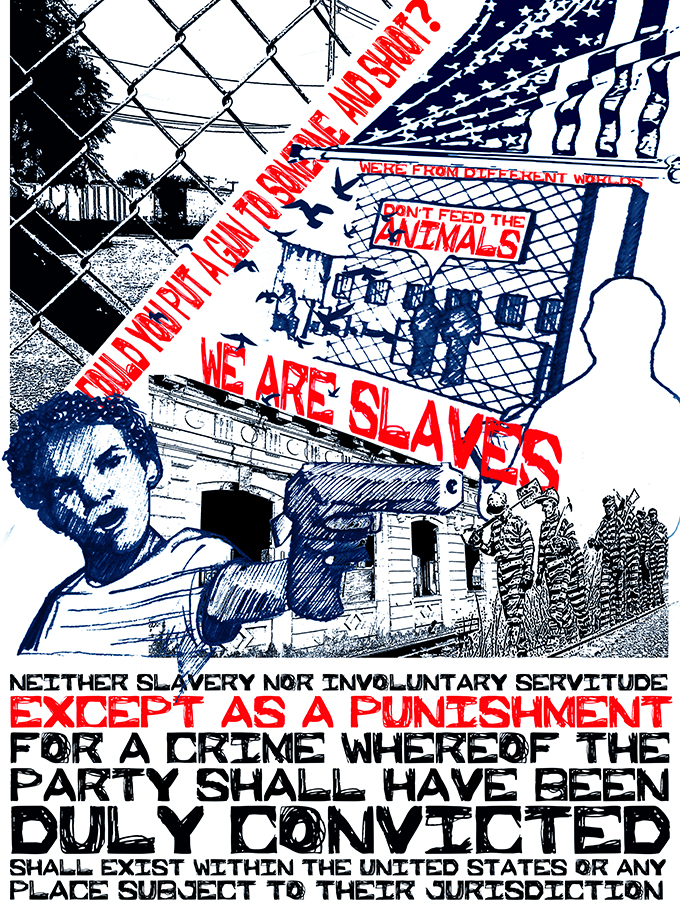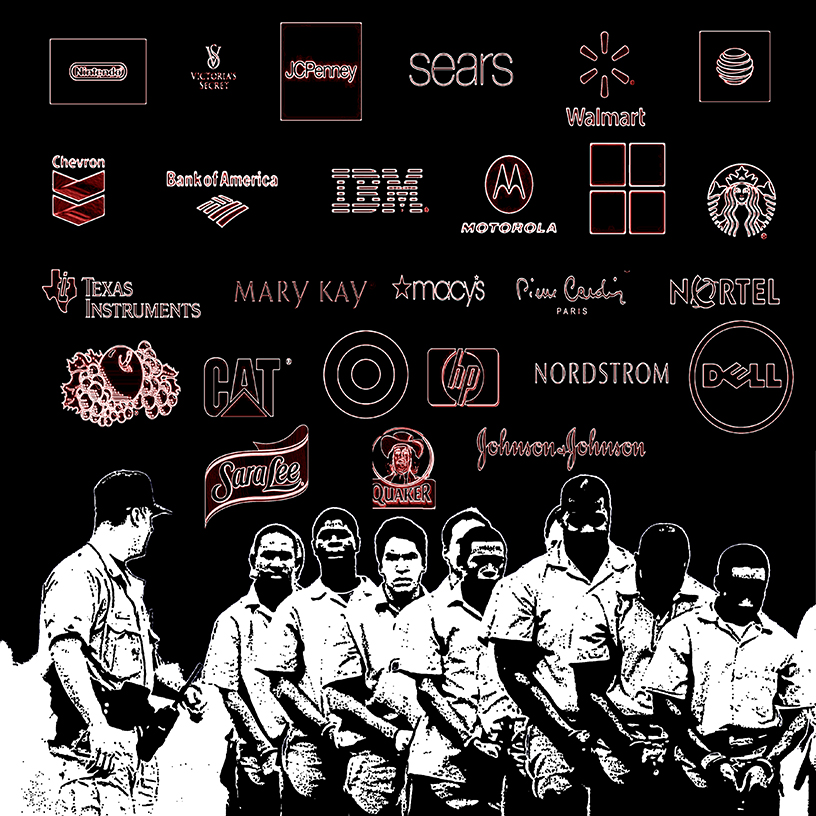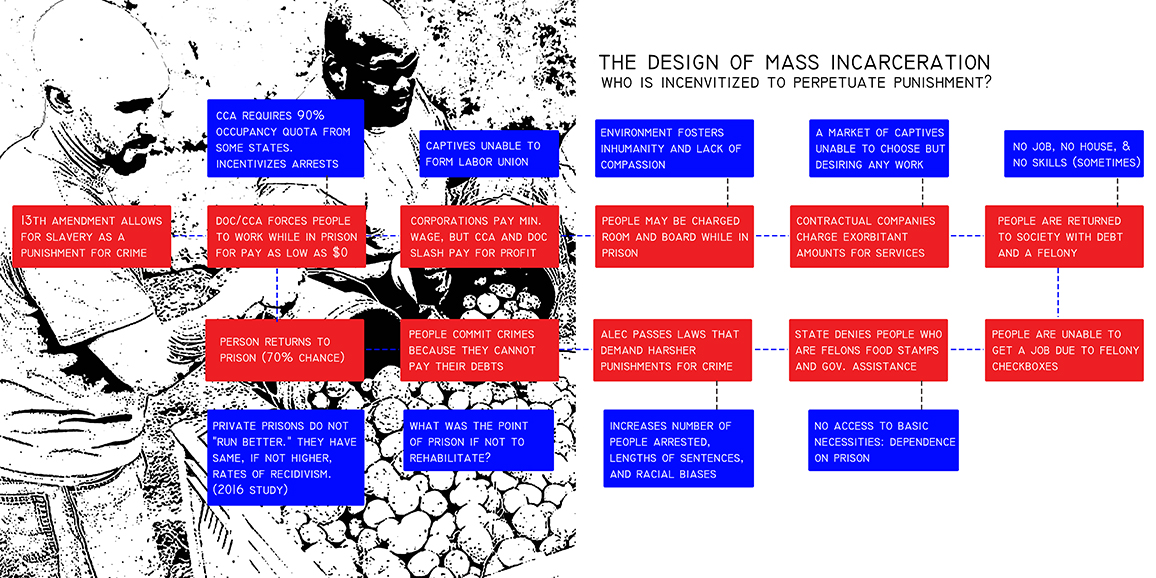The third and final article in our series on the American prison system. —Ed.
Hannah Boyd
For you, DJ, the person who shared part of his life with me.
And for you, former mayor of Indianapolis Greg Ballard, the person who vehemently rejected the concept of prison slave labor, the implications of the 13th amendment, and the profiteering by corporations that makes everyone complicit in the practice of neo-slavery(1).
On day one of our architecture studio, we are tasked with designing a 4,000 bed jail with 27 courtrooms and administrative offices. The project had been an effort by former mayor Greg Ballard to consolidate the sprawling jail network that currently exists in Indianapolis (2). The project never came to fruition, and the new mayor, Joe Hogsett, is currently reviving the project with new ambitions (3).
—

The 13th Amendment
A tall, burly man stalks back and forth, pacing in the dimly-lit, boarded-up bedroom. His name is DJ. We speak for over three hours. He sports a white cap embroidered with an expensive logo. His words are emphatic, punctuated with body language. “I was a drug dealer,” he says. “I had a three-year stint in prison.” His eyes are distant, but his body is engaged. He doesn’t look at you, but around the room. “Prison was heaven compared to jail,” he says.
Thinking of my architecture project, I ask, naively, “Did you get any chance to express yourself in jail?” He stares at me for a second—to check if I’m serious—then bursts into a fit of bitter laughter, looking incredulously around to my colleagues.
“You showered in front of guards, in front of other men, next to strangers,” he said. “All of your belongings were in a single, cardboard box under the bottom bunk in a room of about a hundred other bunk beds. You couldn’t trust anyone, so you didn’t sleep. You woke up restlessly at 6 a.m. to the morning call. Line up at your bed, report your number. You’d eat your breakfast in five minutes or less. Guards would watch you— make sure you didn’t share your food. You weren’t allowed to share your food. I pushed the laundry cart for hours for good behavior. I didn’t have time to finish my GED, because I had to push the laundry cart before I could take classes.”
“I took drug addiction classes for good behavior too. Why don’t they have any classes for drug dealing?” he asks. “I’m addicted to the feel of that money in my hand. Money is a drug.”
He begins to speak about his neighborhood. Shows me a faded tattoo on his left bicep that depicts the street he lives on. He’s lived on the street for his entire life. “I would’ve died for my street back then,” he says. “We used to roll dice in the streets, guns at hand. I got shot in the back once. Didn’t get injured too bad though.”
“Now, all I can see is cousins shooting cousins,” he says. “Brothers shooting brothers. I can’t—” abruptly, he stops. Puts his fingers into the shape of a gun, and looks directly into my eyes. He sticks his pointer finger into my side. He is uncomfortably close, towering over me.
“Could you shoot someone and be okay with it? Does it make me a bad person if I could?”
Dumbfounded, I don’t have a reply.
—
The new Indianapolis jail calls for 4,000 beds. How can you begin to think about the individual person while designing a jail for four thousand people? How can the abstract concept of even “someone in jail” become a real person with thoughts, quirks, loved ones, parents, and a home?
—
A gaggle of college students meanders through aisles of cages with notebooks and pencils. Silly notes are scrawled across the pages. Metal clangs on metal as the vestibule gates shut. The students gawk at the iron bars, stained cots, and barbed wire. “Don’t feed the animals!” one man shouts defiantly, angrily, sarcastically. The tour guide refuses to be fazed and enthusiastically spews euphemisms about the men, their work, and their reformation. “They make twenty-five cents an hour for skilled labor,” she says. “Quite productive members of society,” she says. “Except for those on Ex-Row” (she means Death Row). Those people are in solitary confinement for twenty-three hours a day and cannot see anyone outside of their cells until they are executed by lethal injection somewhere else— somewhere we don’t care about.
Concrete block upon concrete block without breaks for windows. Unending repetition of 6×9 cells. A ceiling so short that some of the men cannot fully stand up. A five-story fence to keep people from committing suicide or murdering their cell-mate. Black bodies veiled in off-white boxers. Naked men showering, their bodies exposed and all vestiges of individuality stripped. Slavery returns: shackles, cages, and white prison guards fingering their guns.
—

Slaves to Corporations
“Through a public-private partnership,” the former mayor says, “the new Indianapolis jail would have been able to house overflow prisoners from other states, thus generating profit for the city of Indianapolis.”
“Private prisons don’t exist,” he says, almost in the same sentence.
“Prisoners make more than twenty-five cents an hour!” he says. “This is preposterous! Corporations don’t use prisoners for labor!”
I pass him a sheet, courtesy of Pulitzer prize-winning journalist, professor, and minister Chris Hedges, that lists thirty-three companies that have or continue to profit from prison slave labor.(4)
Starbucks. Walmart. Dell. Microsoft. Businesses that we all frequent. Businesses with logos ingrained in the recesses of the American consciousness. The former mayor snatches his spectacles from his pocket and hastily grabs the sheet. He is visibly flushed. His tone turns angry. “I don’t believe this,” he says.
Later, he e-mails us, lauding our passion but encouraging us to temper our ‘opinions’ with facts and logic.
—
On the way to a project critique in Indianapolis, my phone vibrates. It’s DJ. I haven’t heard from him in a while but had invited him to the review.
“I just got out of jail,” the text says. “I wanna come, but they towed my car.”
We pick him up at his family’s house. His family is wary of my professor, an older, white man, approaching their doorway. DJ assures his family that he made a commitment, and that he intends to keep it.
At the review, people filter in and out. DJ remains, talking to us for hours.
“Who’s Jim Crow?” He asks, pointing to the label on a diagram.
“The figure representing the demonization of African Americans by white people,” I reply. As author Michelle Alexander asserts in her book The New Jim Crow: It is fair to say that we have witnessed an evolution in the United States from a racial caste system based entirely on exploitation (slavery), to one based largely on subordination (Jim Crow), to one defined by marginalization (mass incarceration). (5)
He pulls up a webpage on his phone excitedly. “I saw something online the other day, he says.” He types in the word ‘black.’ Its synonyms are evil, dark, and mysterious. He looks up ‘white.’ Good. Bright. Pure.
“They teach us to hate ourselves, he says. We’re just part of their game, and I can’t get out.”
—

Design of Mass Incarceration
Mass incarceration— the incarceration of millions of Americans— is an intentional design (6). The design is enforced by legislators and perpetuated by the people who profit from punishment. More often than not, these two groups collude: ALEC, the American Legislative Exchange Commission, allied corporations and legislators for years (7). During its decades-long prominence, ALEC successfully passed many laws that increased the body count in jails and prisons (8).
These laws contribute to the cyclical design of mass incarceration: nationally, 76.6% of people who leave prison return within five years (9). Bodies in; jobless, stigmatized, de-socialized, disenfranchised ‘felons’ out. Repeat.
So why should we build more prisons and jails? More guard towers and cages without windows? Why should DJ filter in and out of jail? Why should we continue to perpetuate this system of greedy retributive justice that, as evidenced by a staggering recidivism rate, clearly does not work?
Maybe we shouldn’t.

A New Design
The architectural response to this research demands reparations from the corporations that have profited from prison labor. These corporations— Starbucks, Walmart, Victoria’s Secret, Dell, Microsoft, Chevron, Bank of America, IBM, Motorola, AT&T, Nintendo, J.C. Penney, Sears, Kmart, Eddie Bauer, Wendy’s, Procter & Gamble, Johnson & Johnson, Fruit of the Loom, Motorola, Caterpillar, Sara Lee, Quaker Oats, Mary Kay, Texas Instruments, Honeywell, Hewlett-Packard, Nortel, Nordstrom’s, Revlon, Macy’s, Pierre Cardin, and Target— will pay for their crimes against the people that they systematically forklifted into the storage warehouses that are jails and prisons (op cit 4).
Corporations will pay these reparations by paying to house the people who are awaiting trial within homes that are near the businesses themselves.
For illustration of this concept, in downtown Indianapolis, there is a Starbucks on Monument Circle. It rests on the first floor of an office building. In this proposal, two of the floors of the office building are renovated into apartments that promote communal living through shared spaces. These apartments are for people who have committed a crime, and are accessible by an elevator that is common to the entire building. This common elevator lessens the stigma attached with having committed a crime. People do not know if you are going to the Starbucks, up the elevator to the offices, or to the apartments.
The Starbucks itself has its own role: it is here that the trials take place. You meet with a judge or official mediator that you’ve met with before. A jury of peers sits next to you. The Starbucks barista brings you hot coffees, on the house, during the deliberation. When the trial is over, you are connected to different services: addiction classes, housing services, etc.; whatever it is that you, as an individual, would like to be connected to.
Perhaps after funding this new system— a system that punishes corporations for decades of profiting from the punishment they sought— corporations would better understand the difference between profit and exploitation.
We drive DJ back to his home after the project critique. His family isn’t at the door this time. He decides to teach us his handshake after we open the van door. It is a simple, loose gripped movement.
“We’re not from the same world,” he says as he departs.
Notes
1. https://www.loc.gov/rr/program/bib/ourdocs/13thamendment.html
2. http://www.indystar.com/story/news/2014/12/11/mayor-ballard-name-preferred-vendor-new-justice-center-complex/20265133/
3. http://www.indystar.com/story/news/local/marion-county/2017/04/04/hogsetts-proposed-jail-would-end-private-contract/100018886/
4. http://www.truthdig.com/report/page2/the_prison_state_of_america_20141228
5. The New Jim Crow: Mass Incarceration in the Age of Colorblindness by Michelle Alexander, page 219
6. https://www.prisonpolicy.org/reports/pie2017.html
7. https://www.alec.org/
8. http://www.alecexposed.org/wiki/Guns,_Prisons,_Crime,_and_Immigration
9. https://www.nij.gov/topics/corrections/recidivism/Pages/welcome.aspx
Hannah Boyd is an architecture student at Ball State University who is interested in how architecture can address questions of social justice.










